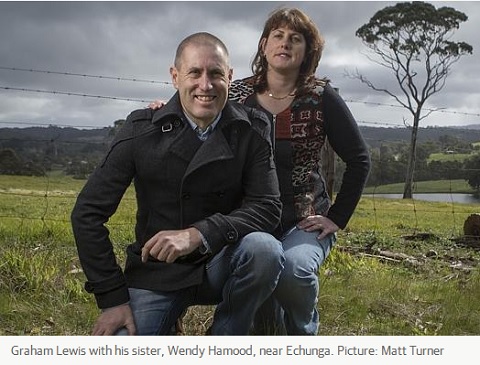Reported by Medical Reporter, Brad Crouch of The Advertiser.
Mrs Hamood, 49, is about to give big brother Graham Lewis, 51, her stem cells in a risky and uncertain move to save him from a rare blood cancer.
Mr Lewis, a former PE teacher now in human resources, helped bring Kanga Cricket to South Australia in his first job with Cricket Australia. The active father’s life changed abruptly when he was diagnosed with Mantle Cell Lymphoma in 2010, a disease that hits up to 350 Australians a year.
After chemotherapy, a stem cell transplant using his own cells in 2011 initially was successful. However, the disease returned this year and his hopes now hinge on a stem cell transplant from a donor – and here is where blood is thicker than water.
Only 25 per cent of siblings are matches. Both Mrs Hamood and brother Ivan, 43, volunteered immediately; Ivan was not suitable but Mrs Hamood was a match.
Mrs Hamood, a veterinarian with two children, knows the importance of family.
“I didn’t hesitate when this happened – I didn’t ever expect to confront something like this, but you play the hand you are dealt and have faith things will work out,’’ she said.
“We were close growing up and knowing Graham’s life is in my hands is a bit scary, but I am making sure I am as healthy as I can be. It is a big responsibility and Graham is depending on me, so I will do the best I can.”
Mr Lewis goes into Royal Adelaide Hospital on Monday for 10 days in isolation, where intense chemotherapy will aim to destroy the cancer but also break down his immune system, leaving him vulnerable to the slightest infection.
He has been checked for potential infection sources including any tiny specks of tooth decay behind fillings.
Mrs Hamood also will enter hospital for a week of hormone injections to encourage her bone marrow to over-produce stem cells.
Her blood will be extracted and put through a separator to harvest the stem cells, which will be injected into Mr Lewis’s blood in the hope he will develop a new immune system free of the lymphoma.
Mr Lewis is well aware of the risks as well as the rewards.
“This is a high-risk procedure only given to those who meet strict criteria, and some people do not survive,” he said.
“The main risks are from infections once the body’s immune system has been wiped out and before the new immune system has developed. Also from graft versus host disease, where the new immune system attacks healthy cells.
“My brother also would do the same if he were a match and I’d do the same for Wendy and Ivan, without hesitation.”
Mr Lewis will still be in hospital on September 17, his 20th wedding anniversary, but his wife and teenage son will be at Elder Park for the Leukaemia Foundation’s national Light the Night fundraiser for research. For more information, visit www.lightthenight.org.au .
STEM CELLS – GRAHAM’S JOURNEY SUMMARIZED
BETWEEN 175 and 350 Australians are diagnosed with Mantle Cell Lymphoma each year, a rare form of non-Hodgkin Lymphoma. Most are men aged over 60 and the cause is not known.
TREATMENT usually involves chemotherapy and radiotherapy. It can then involve a stem cell transplant using stem cells harvested from the patient.
IF this does not work, or if the patient relapses, a donor stem cell transplant may be an option.
ONLY about 25 per cent of siblings are suitable matches, and there are about 22 million adults willing to donate on global registries worldwide.
THE Royal Adelaide Hospital does about 40 stem cell transplants a year, most are for other types of blood cancers, with donors who may be strangers rather than siblings, and not all survive.
IN Graham’s case he will be in strict isolation for 10 days undergoing intensive chemotherapy to kill the cancer while destroying his own immune system, putting him at risk of the slightest infection.
HIS sister Wendy will spend a week injecting herself with a daily dose of Pegfilgrastim, a human granulocyte colony-stimulating factor, which will cause her bone marrow to overproduce stem cells which will flood into her blood stream ready for harvest on the day of the transplant.
BLOOD will be taken from Wendy’s arm, the stem cells separated, then the blood returned. There are few if any side effects for the donor.
THE transplant, where the stem cells are infused into Graham’s bloodstream, is scheduled for August 20, and Graham will spend at least six weeks in hospital hoping the stem cells kick start a new cancer-free immune system, that he remains clear of infections as it does, and that the transplanted stem cells do not attack his organs.






